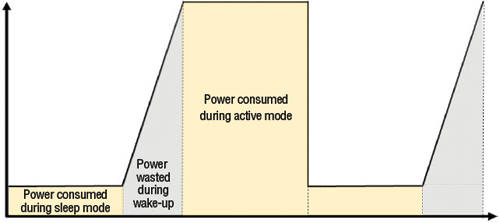The Best Place to Find Help in Creating Low-Power, Energy-Efficient Designs
BY MURRAY SLOVICK
Since it is cheaper and better for the environment to save energy in electronic circuitry than to generate more of it in power plants, it would seem prudent that energy efficiency be considered in any embedded design activity. To reduce power consumption without sacrificing performance requires choosing a combination of the right chips, software and development tools.
Power consumption in a given device is highly dependent on many factors, including the semiconductor process that is used to make the device, operating temperature (there is much higher leakage currents at higher temperatures), operating frequency, level of activity, and operating voltage. For many of these factors, power consumption can be reduced through intelligent design if the engineer has the proper information on the performance of the device and the requirements of a particular application.
The power budget used to select MCUs, for instance, is usually set by the system-level parameters and begins with a thorough definition of the parts’ intended mission, the activities it will perform, and the desired service lifetime. But choosing a low-power MCU can be a time-consuming and difficult task. Even engineers with years of experience may have difficulty establishing a power budget if they rely solely on information from a single supplier’s website since a vendor will only provide data on its own brand parts. So to do a proper comparison requires visiting a number of different sites, which can consume plenty of time. A better idea is to use a single site such as Mouser’s new Low Power application training site, where you can gather the necessary parameters on a wide range of MCUs in one place.
Whether or not you collect data from one or multiple sites, there are a few things you should note. Many data-sheets provide power consumption numbers for the microcontroller without peripherals running. The additional current drawn by the peripherals can be significant.
Consider current consumed by an analog-to-digital converter (ADC), which can vary across sampling speeds and operating modes, so the engineer must look through the datasheet for the mode most appropriate to a given application. Also, internal voltage references are often provided with microcontrollers. These references are used in ADCs as well as comparators and other analog circuits. Often, the current consumed by the voltage reference is not included in the current specifications for the peripheral in use. Similarly, digital interface peripherals — such as UART, I2 C, and SPI — consume battery energy, too.
In general, the power consumption of an MCU is defined by power consumed in its different operating modes, typically active and standby (variously called sleep, hibernate, etc.) for the CPU and on-chip peripherals, and taking into account the power consumed to transition from one mode to another*. Written as an equation, Total power consumed = Active mode power + Standby (sleep) mode power + Wake-up power.

Power consumption stages of a typical MCU. (Illustration courtesy of Silicon Laboratories)
Once these numbers have been derived, a system designer can then factor in the application’s duty cycles — the amount of time the application expects to spend in standby, active, and wake-up modes — to calculate an overall average power consumption number.
Another important tool in determining power consumption can be found in an MCU’s development kit, which can reliably measure a prototype’s current consumption, and may provide supporting software tools that can clearly show the correlation between the current being consumed and the code that’s running. The performance of the code you are planning to run cannot be overlooked; poorly written code itself may turn the unit into a power-hungry application, offsetting the advantages offered by a power-stingy device.
With designing for low power at the forefront of many engineers’ minds, Mouser’s Low Power application training site enables engineers to take a system-wide approach to power budget development and implementation. They can also use it to quickly review new products and technologies, get details on a specific application, or access a complete library of low-power design resources. ■
Advertisement
Learn more about Mouser Electronics





